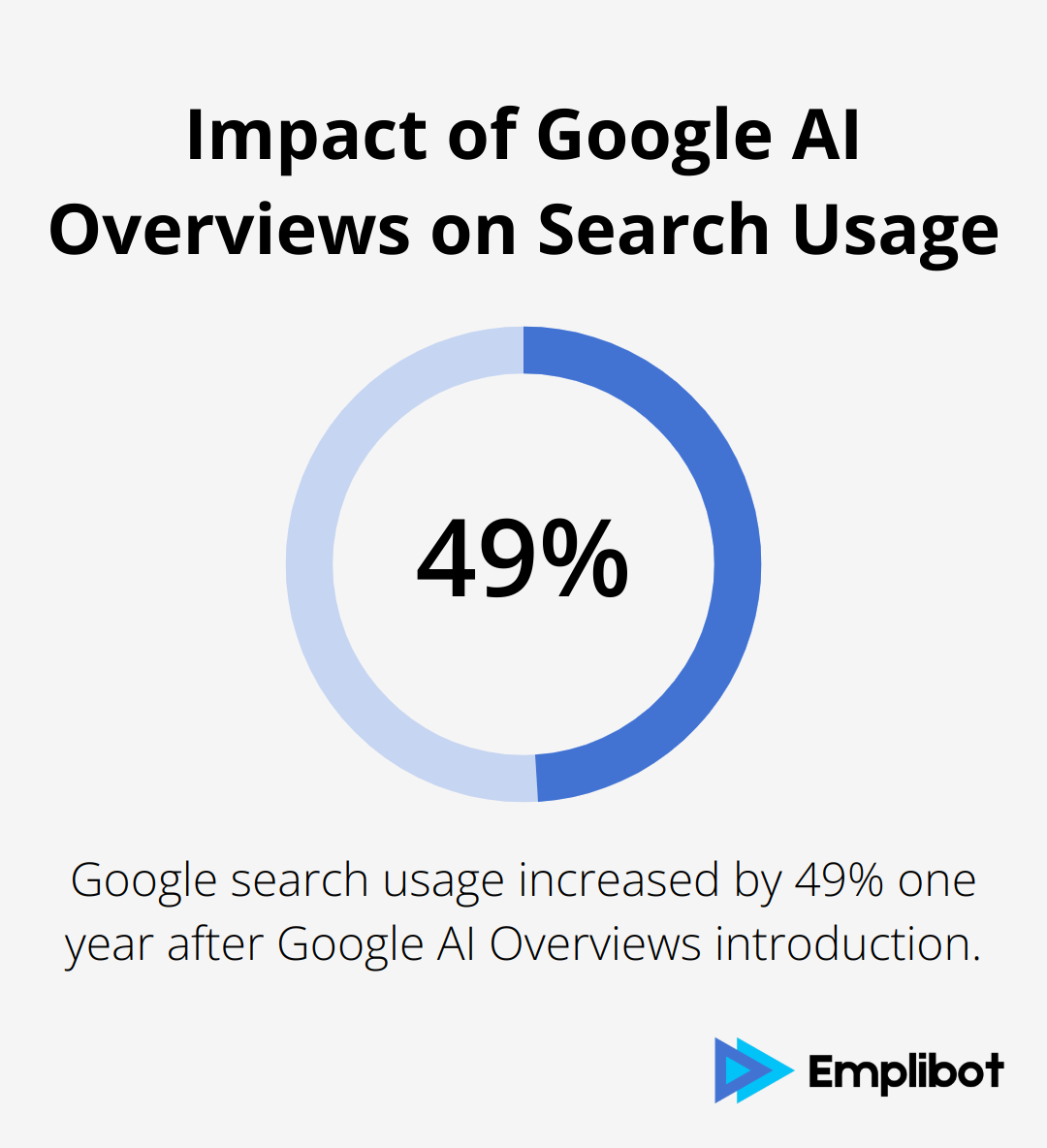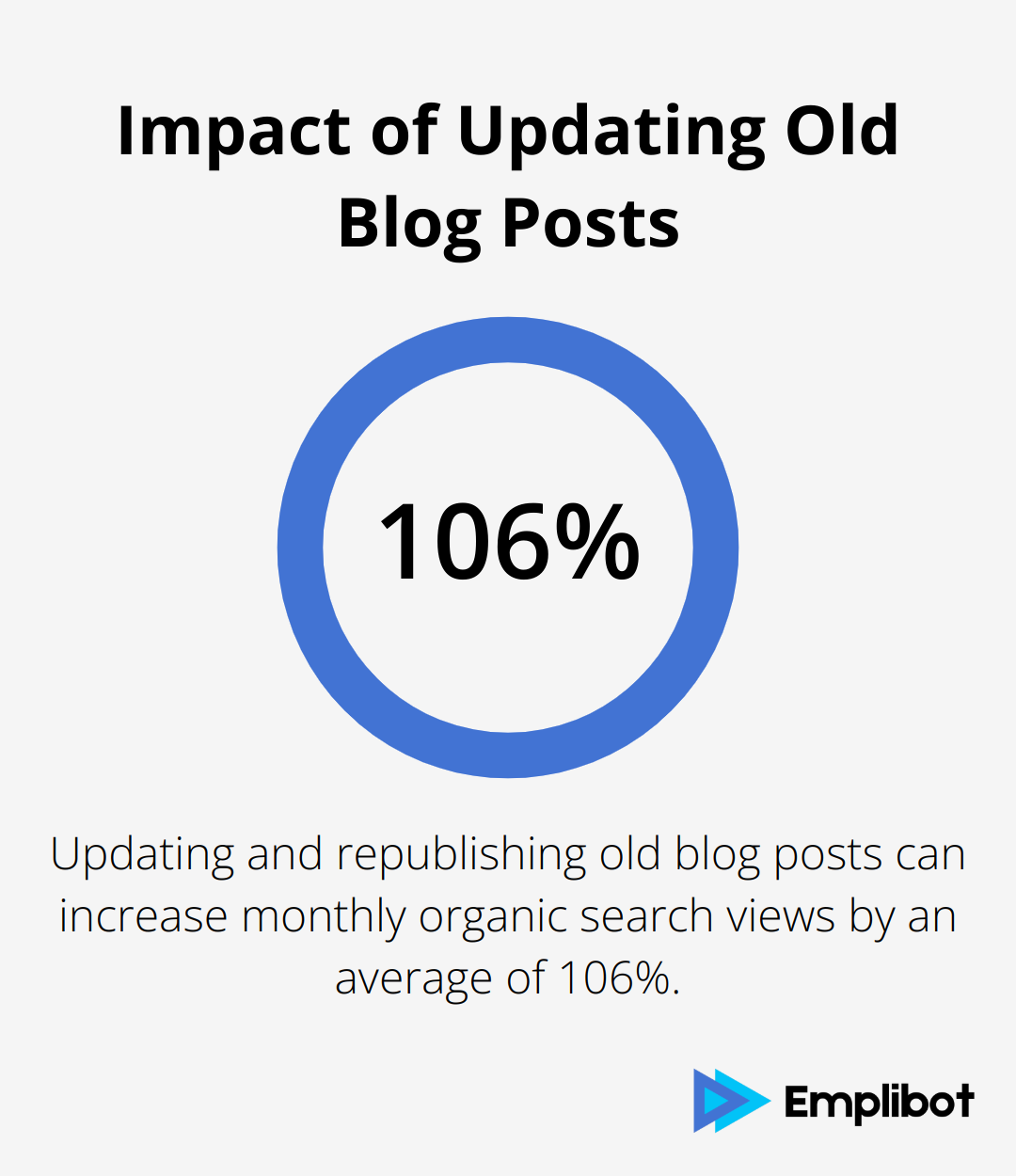SEO content is the cornerstone of online visibility and success. At Emplibot, we’ve seen firsthand how well-crafted, optimized content can skyrocket website rankings and drive massive traffic.
In this post, we’ll share our proven strategies for creating SEO content that not only pleases search engines but also engages your audience. Get ready to boost your online presence and attract more visitors to your site.
What Is SEO Content?
SEO content serves as the driving force behind your website’s visibility in search engine results. It transcends mere keyword insertion; it involves the creation of valuable, informative material that addresses your audience’s questions and resolves their issues.
The Impact of SEO Content on Website Visibility
SEO content transforms website visibility. A BrightEdge study reveals that Google search usage increased by 49% one year after the introduction of Google AI Overviews. This statistic underscores the growing importance of search engines in driving traffic to websites. High-ranking content effectively opens the floodgates to a consistent stream of targeted traffic.

Essential Components of Effective SEO Content
To produce content that ranks well, you must concentrate on three primary elements: relevance, quality, and technical optimization.
Relevance: Addressing Search Intent
Relevance involves tackling the search intent behind your target keywords. For instance, a search for “best running shoes for beginners” likely seeks a comparison of different shoe options, not a technical breakdown of shoe manufacturing processes.
Quality: Providing Comprehensive Information
Quality revolves around offering thorough, accurate information that genuinely assists your readers. Google’s guidelines emphasize the importance of creating helpful, reliable content designed to benefit people. This principle requires you to showcase your expertise and support your claims with credible sources.
Technical Optimization: Structuring for Search Engines
Technical optimization involves structuring your content in a manner that search engines can easily interpret. This includes the use of proper header tags (H1, H2, H3), optimization of meta descriptions, and ensuring mobile-friendliness.
Evaluating SEO Content Performance
To assess the effectiveness of your SEO content, you must monitor key metrics. Tools like Google Analytics can illustrate the amount of organic traffic your content attracts. Metrics such as bounce rate and time on page help evaluate engagement.
SEO requires continuous effort. Regular updates and improvements to your content based on performance data and search trends prove essential for maintaining and enhancing your rankings over time.
As we move forward, we’ll explore the intricacies of creating high-quality SEO content that not only ranks well but also resonates with your target audience.
How to Create High-Quality SEO Content
Master Keyword Research
The foundation of effective SEO content lies in thorough keyword research. Tools like Ahrefs and SEMrush provide valuable insights into search volumes and competition levels. A study by Ahrefs found that 94.74% of keywords get 10 or fewer monthly searches. This fact emphasizes the importance of targeting long-tail keywords, which often have lower competition and higher conversion rates.

When you select keywords, focus on those with clear search intent. For example, if you’re a fitness equipment retailer, targeting “best home gym equipment for small spaces” is more likely to attract potential customers than a broad term like “fitness equipment.”
Craft Compelling On-Page Elements
After you identify your target keywords, optimize your on-page elements. Your title tag should include your primary keyword and be under 60 characters to avoid truncation in search results. According to Moz, pages with a title tag that matches the search query have a 20% higher click-through rate.
Meta descriptions, while not a direct ranking factor, play an important role in attracting clicks. Keep them under 160 characters and include a clear call-to-action. A study by Sistrix found that pages with meta descriptions get 5.8% more clicks than those without.
Headers (H1, H2, H3) help structure your content and make it more scannable for both readers and search engines. Include relevant keywords in your headers, but prioritize clarity and user experience over keyword density.
Write Engaging and Informative Content
The core of your SEO content should provide value to your readers. According to a study by Backlinko, the average word count of a Google first page result is 1,447 words. However, quality trumps quantity. Focus on addressing your audience’s questions and pain points comprehensively.
Use the AIDA model (Attention, Interest, Desire, Action) to structure your content. Start with a compelling hook, build interest through relevant information, create desire by highlighting benefits, and end with a clear call-to-action.
Enhance Content with Multimedia
Incorporating multimedia elements can significantly boost engagement and time on page. A study by Venngage found that articles with images get 94% more views than those without. Include relevant images, infographics, and videos to break up text and illustrate key points.
However, ensure all multimedia elements are optimized for web use. Compress images to maintain fast load times, as page speed is an important ranking factor. Google’s PageSpeed Insights tool can help identify areas for improvement in your site’s loading speed.
Now that you understand how to create high-quality SEO content, let’s explore the best practices that will take your content strategy to new heights and help you achieve better rankings and increased traffic.
How to Maximize SEO Content Impact
Prioritize User Intent
Understanding and addressing user intent is paramount. Discover the strategies brands use to stand out in project management and the importance of consistency for startup success. To capitalize on this, analyze the top-ranking pages for your target keywords. What type of content dominates? Are they how-to guides, listicles, or in-depth articles? Mimic this format while offering unique value.
For example, if you target “best protein powders for weight loss,” don’t just list products. Include nutritional information, usage tips, and potential side effects. This comprehensive approach satisfies user intent and positions your content as an authoritative resource.
Leverage Strategic Linking
Internal linking is a potent yet often underutilized SEO tool. Try to include 3-5 relevant internal links per 1000 words of content. This practice helps search engines understand your site structure and keeps users engaged longer.
External linking to reputable sources can also boost your content’s credibility. However, quality trumps quantity. Choose authoritative sources that genuinely add value to your content.
Keep Content Fresh and Relevant
Search engines favor up-to-date content. Updating and republishing old blog posts can increase the number of monthly organic search views of old posts by an average of 106%. Regularly audit your content, focusing on high-performing pages first. Update statistics, add new insights, and ensure all information remains accurate and relevant.

For instance, if you have a popular post about social media marketing strategies, revisit it quarterly. Add emerging platforms, update algorithm changes, and refresh case studies. This ongoing optimization signals to search engines that your content remains valuable and current.
Optimize for Voice Search and Featured Snippets
Voice search optimization is no longer optional. To capitalize on this trend, focus on natural language and question-based queries. Tools like AnswerThePublic can help identify common questions in your niche.
Featured snippets (often called “position zero”) can dramatically increase visibility. To optimize for snippets, structure your content with clear headings, use bullet points for lists, and provide concise answers to common questions.
Final Thoughts
SEO content forms the foundation of digital success, driving visibility, traffic, and growth for businesses. The strategies we discussed will improve your search rankings and create a sustainable base for long-term online success. SEO content delivers value beyond immediate traffic gains by establishing your brand as an industry authority and building trust with your audience.
The journey to SEO content mastery requires ongoing effort, but the rewards justify the investment. You should implement these strategies step by step, focusing on creating valuable content that addresses your audience’s needs. Optimizing for search engines and refining your approach based on performance data will yield the best results.
SEO content connects real people with genuine value, not just algorithms. Striking this balance will improve your search rankings and build a loyal, engaged audience. For those who want to streamline their SEO content efforts, Emplibot offers a comprehensive solution that automates content creation, optimization, and distribution across multiple platforms. The digital landscape evolves constantly, but SEO content remains a critical factor for online success.

